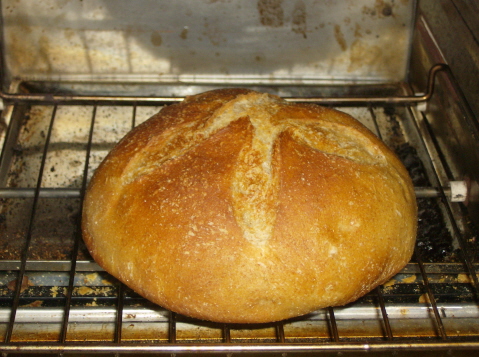This weekend I finally made a loaf of vollkornbrot, which I'd been planning to do for some time. It was a lot of fun, and let me try several things that I had not done before:
- I used the formula from Peter Reinhart's Whole Grain Breads, which includes preparing a mash on the first day. A mash is a thin paste of flour or whole grains and water, kept at 150 for several hours. The goal of this is to produce what I think can best be described as enzyme craziness.
- I've been on a rye kick lately (rye sourdoughs are currently my favorite type of bread), but had not tried anything more than around 2/3 rye. While a 2/3 rye dough is a lot different than a wheat dough, the vollkornbrot dough was much different than either of them.
- I bought a grain mill around a month ago, and while I've been very happy with it, I've been using it almost exclusively to produce finely-ground wheat flour. I'd been holding off using it for rye, as I still have a fair amount of store-bought rye flour to use up. However, the vollkornbrot recipe calls for coarsely-ground rye, so I figured it would be a good opportunity to break out the rye berries I bought. For the mash, I actually produced what I would classify as cracked rye (the recipe calls for rye chops), sifting out the smaller pieces to use as part of the flour for the starter.
Day 1 consisted of preparing the mash mentioned above, along with a starter. Having never made a mash before, I can't really say if mine turned out correctly, but it was gelatinous and quite pleasant-tasting. I've been maintaining both a rye and a whole wheat starter for a couple of months now, and have had good success with both, but I used the rye starter in this recipe just to make the end result 100% rye. Since the expanded starter was made of coarsely-ground rye it did not rise much, but smelled terrific. The mash and starter are pictured below:

On Day 2, I combined the above ingredients along with a good deal more rye flour and a few other items (including, somewhat surprisingly to me, sunflower seeds). On a whim, I used a medium-coarse grind on this additional flour as well. Reinhart lists molasses and cocoa powder as additional optional ingredients, but I decided to leave them out in this batch. After mixing the final dough, I let it proof - the rise was pretty limited, as one might expect, but it was noticeable. Reinhart's instructions have this bread being cooked in an open pan, but based on my reading, I wanted to try it with a lid. However, I do not have a Pullman pan and have sworn off buying any additional kitchen accessories for at least two months. Instead, I used the oft-recommended trick of covering the pan with a baking sheet (weighed down with a cast iron skillet) to roughly approximately a lidded pan.
After around two hours of baking (including rotating the loaf after the first hour so that it cooked more evenly), I pulled the below item out of the oven. I was a little bit disappointed with its appearance, as the flour that I can carefully sprinkled inside the pan and on the top of the loaf had mostly disappeared and there were not as many cracks as I was expecting.

The hardest part of the process was still to come: waiting until Day 3 to sample the loaf. Fortunately, that was today. I'd wrapped the loaf in a towel after it cooled yesterday, and when I took it out this evening, it smelled terrific. Cutting through that crust was a bit of a challenge (as expected), but once I made it through, the crumb was quite soft with a very unique texture. Reinhart says that using a mash gives the crumb a creamy texture, and while I didn't really know what that meant before trying this bread, I have to say that "creamy" is probably the word for it. The taste was very complex - it didn't have much of a rye flavor, but I could detect the sourness from the starter, the sweetness from the mash, a hint of the taste of the sunflower seeds, and many other factors that I can't quite place. For the first time I can remember, I wish that a loaf I made had more crumb and less crust. I will also be interested to see how the flavors continue to develop over the next several days. I've included a photo of the crumb below.

Overall, this was a very satisfying bake for me. I love trying new ingredients and techniques, and when they actually produce something this tasty, it's even better! I will definitely be baking more vollkornbrot in the future, although I think I may first try a few of the lighter recipes I've been neglecting. I also plan to save some of this loaf to provide altus, perhaps for Reinhart's Bavarian Pumpernickel recipe. In addition, I'm now more interested than ever in trying my mill out on different grains and coarser grinds. So many breads, so little time...







